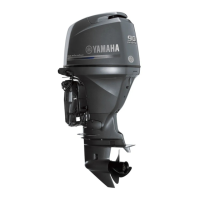Maintenance
80
EMU44491
Cleaning and adjusting spark plug
The spark plug is an important engine com-
ponent and is easy to inspect. The condition
of the spark plug can indicate something
about the condition of the engine. For exam-
ple, if the center electrode porcelain is very
white, this could indicate an intake air leak or
carburetion problem in that cylinder. Do not
attempt to diagnose any problems yourself.
Instead, take the outboard motor to a
Yamaha dealer. You should periodically re-
move and inspect the spark plug because
heat and deposits will cause the spark plug to
slowly break down and erode.
1. Remove the spark plug caps from the
spark plugs.
2. Remove the spark plug. If electrode ero-
sion becomes excessive, or if carbon
and other deposits are excessive, you
should replace the spark plug with an-
other of the correct type. WARNING!
When removing or installing a spark
plug, be careful not to damage the in-
sulator. A damaged insulator could al-
low external sparks, which could lead
to explosion or fire.
[EWM00562]
3. Be sure to use the specified spark plug,
otherwise the engine may not operate
properly. Before fitting the spark plug,
measure the electrode gap with a wire
thickness gauge; replace it if out of spec-
ification.
4. When fitting the plug, wipe off any dirt
from the threads, and then screw it in to
the correct torque.
If a torque-wrench is not available when you
are reinstalling a spark plug, a good estimate
of the correct torque is 1/12 turn past finger-
tight. When you are installing a new spark
plug, a good estimate of the correct torque is
1/2 to 2/3 turn past finger-tight.
EMU29045
Inspecting idle speed
EWM00452
Do not touch or remove electrical parts
when starting or during operation.
Keep hands, hair, and clothes away
from the flywheel and other rotating
parts while the engine is running.
Standard spark plug:
LFR5A-11
1. Spark plug gap
2. Spark plug part number
3. Spark plug I.D. mark (NGK)
Spark plug gap:
1.0–1.1 mm (0.039–0.043 in)
Spark plug torque:
25 Nm (2.55 kgf-m, 18.4 ft-lb)
U6D63EE0.book Page 80 Friday, December 12, 2014 9:39 AM
©2019 Yamaha Motor Corporation, U.S.A.

